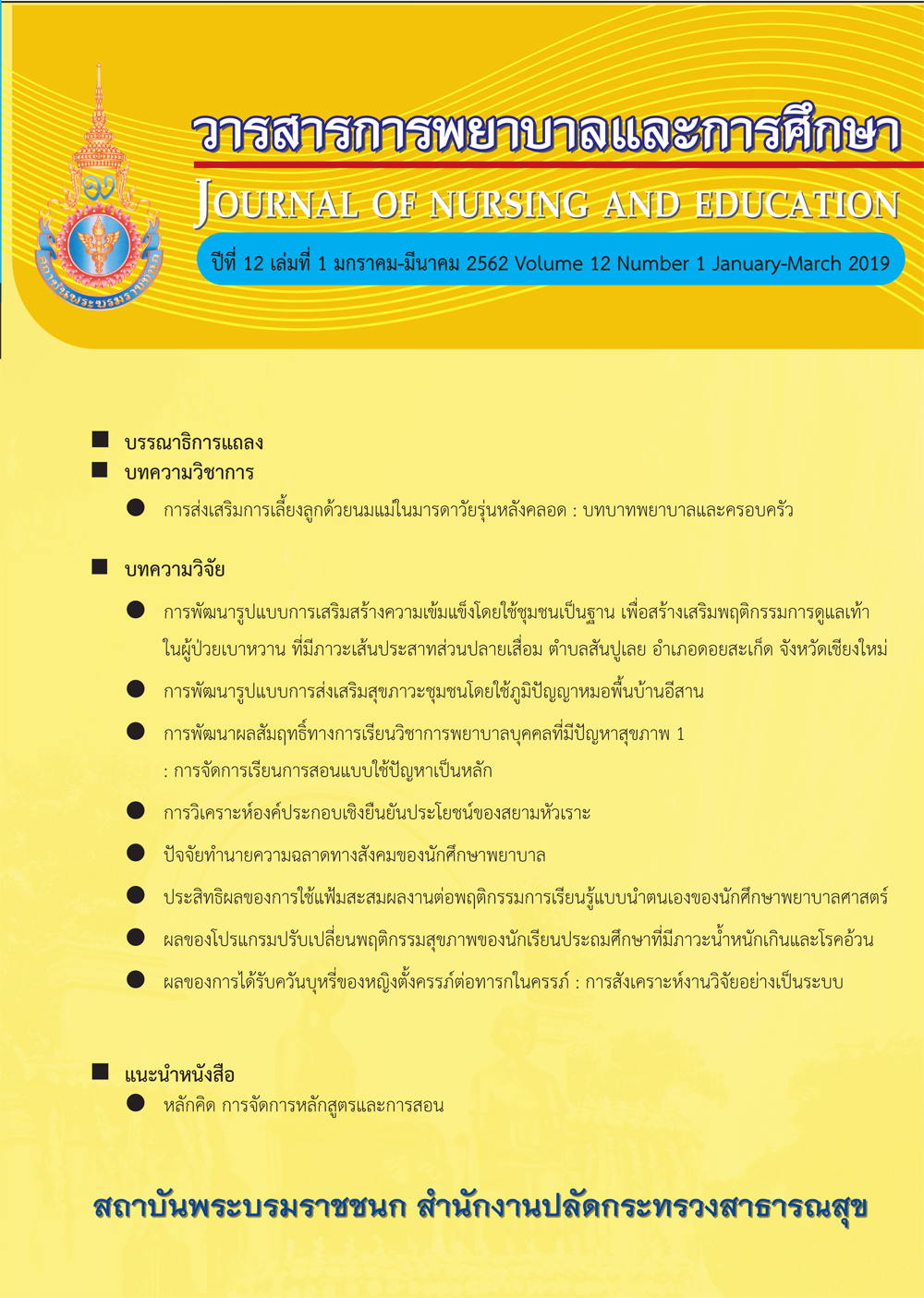การพัฒนาผลสัมฤทธิ์ทางการเรียนวิชาการพยาบาลบุคคลที่มีปัญหาสุขภาพ 1 : การจัดการเรียนการสอนแบบใช้ปัญหาเป็นหลัก
การพัฒนาผลสัมฤทธิ์ทางการเรียนวิชาการพยาบาลบุคคลที่มีปัญหาสุขภาพ 1 : การจัดการเรียนการสอนแบบใช้ปัญหาเป็นหลัก
คำสำคัญ:
การสอนแบบใช้ปัญหาเป็นหลัก, ผลสัมฤทธิ์ทางการเรียน, ความสามารถการแก้ปัญหาการพยาบาลบทคัดย่อ
บทคัดย่อ
การวิจัยกึ่งทดลอง (Quasi Experimental Research) นี้ มีวัตถุประสงค์ เพื่อเปรียบเทียบผลสัมฤทธิ์ทางการเรียนของนักศึกษาพยาบาลกลุ่มที่ได้รับการสอนแบบใช้ปัญหาเป็นหลักกับกลุ่มที่ได้รับการสอนแบบปกติ กลุ่มตัวอย่างเป็นนักศึกษาหลักสูตรพยาบาลศาสตรบัณฑิต ชั้นปีที่ 2 ภาคเรียนที่ 2 ปีการศึกษา 2560 แบ่งเป็นกลุ่มทดลองและกลุ่มควบคุม กลุ่มละ 75 คน โดยการเลือกตัวอย่างแบบเจาะจงตามเกณฑ์ที่กำหนดไว้ กลุ่มควบคุมจะได้การจัดการเรียนการสอนแบบปกติ ส่วนกลุ่มทดลองจะได้รับการจัดการเรียนการสอนแบบใช้ปัญหาเป็นหลัก เครื่องมือที่ใช้ในการวิจัยประกอบด้วย 1) แผนจัดการเรียนรู้แบบใช้ปัญหาเป็นหลัก 2) แผนจัดการเรียนรู้แบบปกติ 3) แบบทดสอบผลสัมฤทธิ์ทางการเรียน และ 4) แบบวัดความสามารถการแก้ปัญหาการพยาบาล ผู้วิจัยเก็บข้อมูลโดยใช้แบบทดสอบผลสัมฤทธิ์ทางการเรียนและแบบวัดความสามารถการแก้ปัญหาการพยาบาล ก่อนและหลังการสอนแบบใช้ปัญหาเป็นหลัก เก็บรวบรวมข้อมูลระหว่างกุมภาพันธ์ - มีนาคม 2561 วิเคราะห์ข้อมูลด้วยสถิติความถี่ ร้อยละ ค่าเฉลี่ย ส่วนเบี่ยงเบนมาตรฐาน และเปรียบเทียบคะแนนเฉลี่ยภายในกลุ่มทดลองและกลุ่มควบคุมโดยใช้สถิติ Paired Sample t – test และระหว่างกลุ่มทดลองและควบคุมโดยใช้สถิติ Independent Sample t – test
ผลการวิจัยพบว่า ค่าคะแนนเฉลี่ยผลสัมฤทธิ์ทางการเรียนของกลุ่มทดลอง สูงกว่าก่อนทดลองและสูงกว่ากลุ่มควบคุม อย่างมีนัยสำคัญทางสถิติ .001 ดังนั้น ผู้วิจัยมีข้อเสนอแนะให้นำแนวทางการจัดการเรียนการสอนแบบใช้ปัญหาเป็นหลักนี้ไปขยายผลในการจัดการเรียนการสอนวิชาอื่นสำหรับนักศึกษาพยาบาล เพื่อส่งเสริมให้เกิดการพัฒนาความสามารถในการแก้ ปัญหาการพยาบาลให้มีประสิทธิภาพยิ่งขึ้นต่อไป
References
1. Offce of the National Education
Commission. National Education Act,
1999 (RevisedEdition 2002). Bangkok:
The Offce of the Prime Minister, 2002.
(in Thai)
2. Internal Quality Assurance Committee.
Internal Quality Assurance Manual for
Higher Education. 2nd ed. Bangkok:
Tanapress Company, 2017. (in Thai)
3. Hsu, L. Developing Concept Maps
from Problem-based Learning Scenario
Discussions. Issues and Innovations in
Nursing Education, 2004; 48(5): 510-518.
4. Savery, J. R. Overview of Problem-based
Learning: Defnitions and Distinctions.
Interdisciplinary. Journal of Problem
Learning, 2006; 1(1): 8-20.
5. Hamdan, A.R., Kwan, C.I., Khan, A., Ghafar,
M.N.A., Sihes, A.J. Implementation of
Problem Based Learning among Nursing
Students. International Education
Studies, 2014; 7(7): 136-142.
6. Dolmans, D.H.J.M., Grave, W.D., Wolfhagen,
I., & Vleuten Van Der, C.P.M. Problem
Based Learning: Future Challenges for
Educational Practice and Research.
Medical Education, 2005; 39: 732-741.
7. Instructors of Boromarajonani
Institute. Teaching and Learning
Manual for Problem-based Learning in
Boromarajonani Colleges of Nursing.
Nonthaburi: Yutarin Press, 2015. (in Thai)
8. Makmee, P. Problem-based Learning.
EAU Heritage Journal, 2011; 5(1): 7-14.
(in Thai)
9. Suwannoi, P. Problem-based Learning:
PBL. Documentation for the Description
in the Development of Teaching and
Learning [online]. 2015 [cited 2015/9/10].
Available from: https://ph.kku. ac.th/
thai/images/fle/km/pbl-he-58-1. pdf.
(in Thai)
10. Praboromarajchanok Institute for Health
Workforce Development. Manual Book
Guideline for Problem-based Learning
Model for Nursing Instructors under
Praboromarajchanok Institute for Health
Workforce Development. Nonthaburi :
Yutharinkanpim, 2015. (in Thai)
11. Chandee, M., Pale, P., Niamhom, P.,
Jongkae, P., & Sengpanit, T. Effect of
Case Study Teaching in the Subject of
Nursing Care for Person with Health
Problems Practicum I on Nursing
Students Abilities of Applying Nursing
Process. Journal of Nursing and Education,
2014; 7(4): 134-155. (in Thai)
12. Sungur, S. & Tekkaya, C. Effects of
Problem-based Learning and Traditional
Instruction on Self-regulated Learning.
The Journal of Educational Research,
2006; 99(5): 307-317.
13. Thailand Nursing and Midwifery
Council. Nursing and Midwifery Institute
Certifcation Manual for Educational
Institutions which Graduates of Bachelor
of Nursing Science Program. Nonthaburi:
Joodtong Company Ltd., 2013. (in Thai)
14. 14. Schmidt, H. G. and Moust, J. H. C.
Processes that Shape Small-group
Tutorial Learning: A Review of Research.
Mastricht: Datawyse Publishing, 2000.
15. Newman, M. J. Problem-based Learning:
An Introduction and Overview of the
Key Features of the Approach. JVME,
2005; 32(1): 12-20.
16. Saart, S., Piriyasurawong, P. Ninsok, P., and
Jerungsuwan, N. A Development of the
Problem-based Instruction Model Using
Electronic Media (PBIMUEM) on Learning
Achievement and Problem Solving
Ability of Nursing Students in Nursing
College under Praboromarajchanok
Institute. Academic Services Journal,
2012; 22(3): 150-162. (in Thai)
17. Imanieh, M.H. & Sobhani, A.R. Evaluation
of Problem-based Learning in Medical
Students’ Education. Advance Medical
Education Prof. Journal, 2014; 2(1): 1-5.
18. Kanyamee, T. & Thongpoon, C. Problembased Learning on Achievement and
Problem Solving Abilities in Science of
Mathayomsuksa II Students on the Topic
of Food and Existence, p. 355-365. In
the National Academic Symposium of
Graduate Network in North Rajabhat
University, 16. Phetchabun: Phetchabun
Rajabhat University, 2016. (in Thai)






